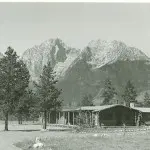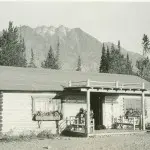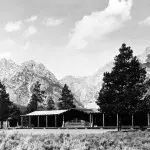The Square G Ranch was homesteaded and owned by Albert and Lida Gabbey. The couple first moved to Jackson Hole in 1925 after hearing about the scenic valley from friends. They rented a cabin in Kelly the first winter and made the acquaintance of Homer Richards. Richards had a homestead near Jenny Lake and was well-known throughout the valley for his barbershop and gas station. Richards encouraged the Gabbeys to take up their own homestead on Jenny Lake. Initially, Gabbey intended to open a small tourist lodging facility, but soon learned that there were several options already nearby, including on Richards’ land. Gabbey and Richards struck a deal to allow Gabbey to rent one of his tourist cabins and to build a store on the property. Gabbey constructed the Square G Shop and sold perishable produce, meat, and dairy products from nearby ranches, canned goods, camping and fishing supplies, and film. The presence of the new store and existing gas station no doubt helped to attract visitors to the Richards property and tourist cabins. Gabbey later filed on a 126-acre homestead entry and was awarded the patent in 1931.
Gabbey filed for a second patent in 1927, this time for 236 acres under the Stock Raising Act of 1916. At the same time, the Snake River Land Company was forming with the purpose of purchasing homesteads throughout Jackson Hole before commercial interests entered the valley. The Snake River Land Company’s primary members consisted of John D. Rockefeller, Jr., Vanderbilt Webb, and Harold Fabian. Rockefeller had toured the valley and became concerned about the probability of commercial developers creating large resorts and subdivisions. He began secretly purchasing homesteads and ranches using the Snake River Land Company name with the intention to donate the land to the federal government for protection. When Albert Gabbey filed his 326-acre claim at the Wilson land office, several red flags were raised. One of the most “threatened” areas in the eyes of Rockefeller and his Land Company contained Jenny, String and Leigh Lakes. The Land Company maneuvered to deny the approval through the land office, hoping to prevent further development around Jenny Lake.
The Gabbeys continued to successfully operate their store with the addition of the Jenny Lake Post Office—with Mrs. Gabbey as postmaster. They constructed a few small cabins on their own homestead with the purpose of renting them out to overnight tourists. In 1929 the Gabbeys would experience another painful episode with the Snake River Land Company. Homer Richards had sold his homestead, which included the land the Square G Shop stood on. Gabbey wrote to Harold Fabian explaining that he alone owned the building and it had no legal standing in the sale. However, Fabian was determined to rid Jenny Lake of all the “improvements” and this included the burgeoning Square G Ranch. It was thought that without his shop, Gabbey could be persuaded to sell the rest. Instead of backing down, Gabbey organized a small group of neighbors and friends to dismantle his building and rebuild it on a neighbor’s private land.
Since Gabbey legally owned the building, there was not much Fabian could do. However, the Land Company maneuvered to deny Gabbey’s 326-acre Stock Raising application through the land office. When the Secretary of the Interior eventually heard about the scuffle, they ordered the patent to be approved in 1940. The Snake River Land Company had no jurisdiction to influence the land office, and the whole matter helped to fuel local rumors that the company had an illegal partnership with the National Park Service. Later court filings ultimately found no wrong doing. With the Square G Shop saved for the time being, the Gabbeys focused on expanding their small ranch into a motor court. By 1934, five cabins had been constructed, each with two to three rooms. These were termed “housekeeping” cabins, which meant that guests looked after their own needs. Full kitchens were provided, so the guests were not reliant on the dining room. Despite the conveniences, Mrs. Gabbey’s unrivaled cooking was known throughout the valley, and many cabin kitchens went unused. A year later, four more one room cabins were constructed. Eventually more than 30 cabins were constructed on the property.
Around 1936 the Gabbeys sold the old Square G Shop to the Novotnys, where it was later acquired by J.D. Kimmel and renamed the Jenny Lake Store. Albert Gabbey built the new Square G Store across the highway from the ranch and expanded the inventory into novelty items, silver jewelry, Navajo rugs, Kodak film and tobacco. Local artists Archie Teator and Harrison Crandall also sold their works. A Shell service station was added with two gas pumps were added. The Square G had survived the earlier legal turmoil to emerge as one of the best-known ranches in the valley for its food and its rates. Because it wasn’t a true dude ranch, the Gabbeys offered overnight rates starting at $2.00 (and up to $4.00) and weekly rates starting at $12.50 (and up to $25.00). Rates varied due to housekeeping and maid service and the size of the cabin (one to three room options). All comfort necessities like bedding and towels were provided, and the ranch was centrally located for a wide variety of concessionaire-owned activities. Horseback riding, hiking, fishing and mountain guides were all located nearby at the south end of Jenny Lake.
In 1947 Albert died, leaving his wife Lida with the ranch. She continued to operate it for a few years, but the responsibilities were difficult and she was no longer young. In 1950 she contacted Harold Fabian to discuss terms for selling. Feeling confident about the price, the sale went through and management transferred to the Jackson Hole Preserve-owned (formerly Snake River Land Company) Grand Teton Lodge Company. Lida continued to travel to the Square G for the summers before age caught up with her. In 1954 the Preserve had decided to close the ranch and move the buildings to the newly planned facility at Colter Bay. Today, the Square G’s memory lives on in the relocated cabins at Colter Bay. Their distinctive shaggy bark exteriors (the logs were never trimmed of their bark) mark them as Square G buildings.
Text by Samantha Ford, Director of Historical Research and Outreach




